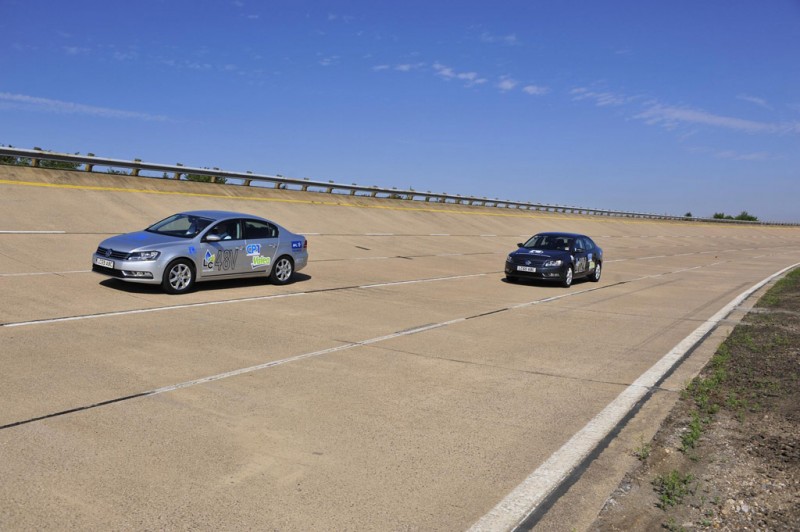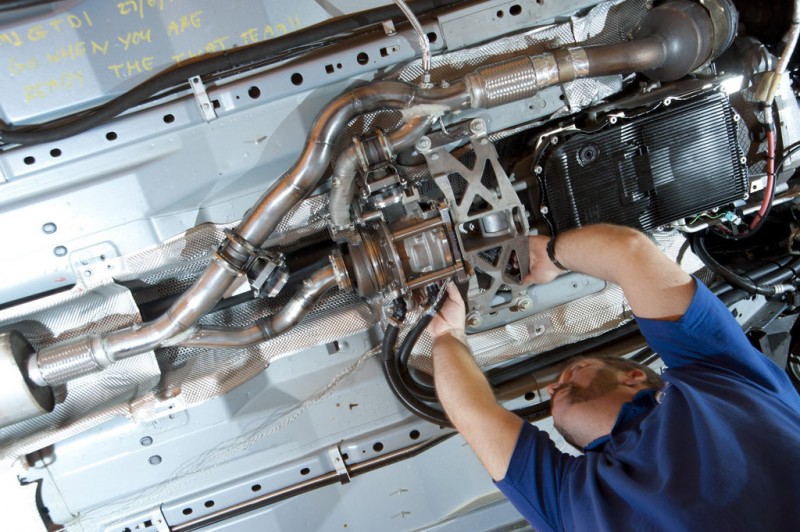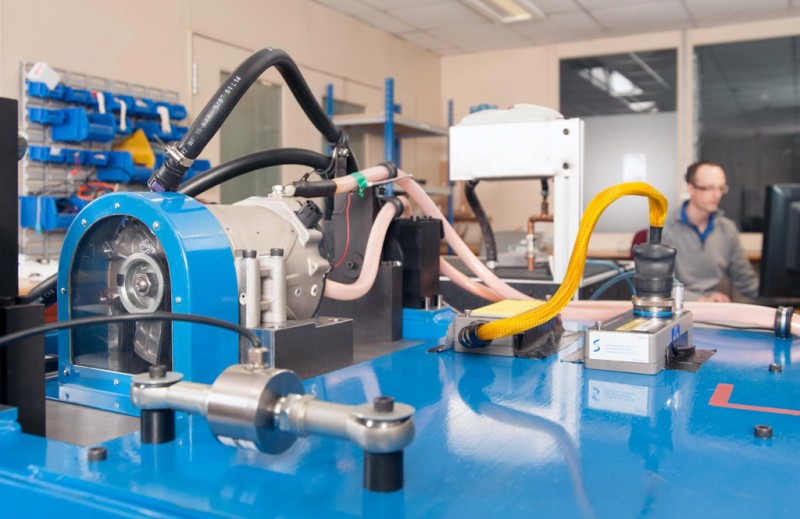Controlled Power Technologies (CPT) will deliver two technical papers at the 80th anniversary of the SAE World Congress being held at the Cobo Center in Detroit on 8-10 April 2014. The first presentation describes its SpeedStart® torque assist and kinetic energy recovery system; the second its turbine integrated gas energy recovery system known as TIGERS®. Both systems are based on switched reluctance (SR) motor-generator technology developed for a new breed of 48V mild hybrid vehicles and are at a high level of automotive application readiness.
The technical papers will be presented in room 140F on Wednesday 9 April 2014 in an SAE session commencing 8am that morning covering the electric motor and power electronics required for vehicle electrification as organised by the SAE hybrid and electric powertrains committee. The award winning company is also exhibiting its technology on booth 422 at this annual SAE event.
CPT’s chief executive Nick Pascoe, said:
“Vehicle electrification and in particular mild hybridisation of a conventional powertrain at 48V is a rapid growth area for the automotive industry. As a reduced cost concept, it aims to make more intelligent use of electrical energy to achieve the desired reduction in fuel consumption and CO2 emissions. The low voltage approach compared with full hybrid and EV nominal voltages, which are typically in the range of 300 to 600V, avoids the need for high cost safety features and large battery packs.”
Working closely with many international automotive companies, CPT as a technology developer has been consistently in the forefront of hybrid vehicle innovations and was one of the first to spot the opportunity for low voltage electrification of the powertrain. Pascoe, said:
“Sixty volts is defined by the United Nations Economic Commission for Europe (UNECE) regulation R100 as the boundary between low and high voltage in a direct current circuit, and so is a critical point where a step change in system cost can be identified. Further standards such as LV-148 as defined by the Verband der Automobilindustrie (VDA) are providing further structure to the 48V nominal voltage approach, which allows high power energy recuperation without exceeding 60V.”
SpeedStart
CPT’s SpeedStart paper describes the specification of a 48V belt integrated starter generator (B-ISG) developed to meet the growing market demand for low voltage mild hybrid passenger vehicle applications. The main areas discussed are the vehicle and application variations, considered both in terms of electrical and mechanical architecture and how these transfer into the motor design. The paper focuses in particular on the challenges of balancing the need to customise the motor for different applications against the need to maintain common variants to minimise cost, reduce risk and accelerate development cycles.
Peter Scanes senior manager for SpeedStart who co-authored the SpeedStart report with lead applications engineer John Kelly and senior engineer for powertrain systems implementation Paul Bloore, said:
“The number of architectures under consideration for 48V systems is still growing, particularly across different vehicle classes. This results in a range of system level requirements from different manufacturers, dictated by vehicle targets and other issues such as battery state-of-charge and energy storage capability.”
“By maintaining a common core of rotor and stator laminations and a common coolant system, it is possible to accelerate the development of each application. This common core also provides greater confidence in the robustness of prototypes, while minimising the cost of variants further supports the development of 48V systems. SR machines are ideally suited to this concept of low cost development, while reducing the cost of production components. Moreover, compared with other electrical machines they have a high efficiency across a large speed range, good controllability, and reliability.”
Scanes, said:
“For SpeedStart, we’ve established the critical design rules covering for example the optimum packaging and overall geometry of a 12.5kW belt-integrated starter generator. The commonality of machine variants allows relatively easy variation of performance for different applications including trade-offs between peak torque, peak power, steady state power and other requirements from the electrical and mechanical systems. Sophisticated modelling of the control and power electronics in addition to the electromagnetics of the motor are essential to this capability and means our control strategy can allow each machine to operate closer to the real motor limits seen in varied automotive duty cycles.”
TIGERS
CPT’s technical paper describing its turbo-generator integrated gas energy recovery system known as TIGERS is similarly focused on the simulation, machine design, control system development and validation of the technology. The unit can be applied to naturally-aspirated or forced induction engines – though most likely will be applied to downsized turbocharged engines as an additional unit to the existing turbocharger.
Andy Dickinson senior manager responsible for CPT TIGERS/COBRA technology, who co-authored the report with applications engineer Andrew Haughton and senior manager for advanced engineering Dr Rick Quinn, said:
“Although combustion engine turbochargers are now commonplace, replacing a compressor with an electrical generator to create a separate thermal energy recovery system, offers a set of unique design challenges – particularly given that the exhaust of a conventional road vehicle is a highly transient environment with regards to mass flow and temperature.”
“In spark ignition applications the exhaust gas can reach temperatures greater than 900°C. Considering that the switched reluctance machine at the heart of the TIGERS technology is expected to harvest energy from the exhaust gas, it is essential that it not only survives in this extreme environment, but also produces work without ruining vehicle performance or fuel efficiency. To ensure that the bearing system, generator core and integrated electronics are all kept within their working ranges, the coolant system taps into the engine coolant to operate between 80 and 105°C.”
Commenting on the 75 per cent of vehicle fuel combustion energy typically lost through waste heat Rick Quinn says:
“Waste heat energy recovery concepts gaining interest for automotive applications include thermoelectric generation (TEG) and organic Rankine Cycle systems, whilst heavy duty markets already offer mechanical turbo-compounding systems as an efficient solution where space is less restricted.”
“The concept of direct turbo generation, using a turbine coupled to an electrical generator to extract the potential and kinetic energy of the fast flowing exhaust gas, differs significantly from these waste-heat recovery devices, which rely solely on heat transfer to extract energy. With a correctly specified turbine, there is the potential to harvest significant electrical energy over a large proportion of the engine operating range as the turbo-generator can take advantage of both temperature and mass flow rate of the exhaust gas provided by the engine.”
As with the SpeedStart device, the liquid cooled switched reluctance generator at the core of the TIGERS technology provides many benefits over conventional permanent magnet generators. Due to the absence of rotor windings, SR machines possess low rotating inertias thus minimising rotor losses. In addition, due to the exclusion of permanent magnets there is no risk of torque loss due to de-magnetisation or uncontrolled generating modes at high-speed.
The SR type generator also facilitates cost savings across the design, including minimal tooling investment due to the straightforward motor construction and a reduction in the rating of the power electronics due to low switching frequencies. The 65,000rpm high speed capability of the Tigers electrical generator also facilitates a direct coupling to the turbine rather than a reduction gear set. This reduces the number of components in the device, making the unit design inherently lighter, cheaper to manufacture and simpler to assemble in both its prototype and volume production form.
SpeedStart and TIGERS will underpin Advanced Diesel Electric Powertrain project known as ADEPT
The TIGERS system has already benefited from two research projects supported by the UK’s innovation agency, the Technology Strategy Board (TSB). The HyBoost project consortium partners included CPT, the European Advanced Lead Acid Battery Consortium, Ford, Imperial College London, Ricardo and Valeo; and the Vehicle Integrated Powertrain Energy Recovery project known as VIPER consortium members comprised BP, CPT, Ford, IAV, Imperial College London, Jaguar Land Rover, and the University of Nottingham.
CPT’s SpeedStart and TIGERS technology will now be incorporated into the recently announced Advanced Diesel Electric Powertrain project known as ADEPT. The ADEPT project combines the two technologies, which have been demonstrated individually but not yet as an integrated system, applying the low voltage concept of ‘intelligent electrification’ for the first time to a diesel car – again supported by the TSB. For the ADEPT project, the consortium comprises CPT, the European Advanced Lead Acid Battery Consortium (EALABC), Faurecia Emissions Control Technologies, Ford and the University of Nottingham. The management of the project will be handled by Ricardo.
Keeping the voltage below the critical 60 volt high voltage safety threshold, the nominal 48 volt technologies to be applied to a Ford Focus aim to deliver a breakthrough in diesel engine fuel efficiency and CO2 reduction by demonstrating full hybrid equivalent fuel economy and performance with less than 70g/km CO2emissions, but at significantly lower cost. The combination of various technologies and slight engine downsizing from the baseline 1.6-litre diesel engine is expected to deliver significant synergy and cost effective benefits without compromising vehicle performance.
SpeedStart and TIGERS technologies are aimed not only at the C-segment car platform represented by the Ford Focus, but also are relevant from the B-segment to the largest passenger car and rapidly growing SUV platforms. In the UK and Europe, B to D segment vehicles are responsible for almost 80 per cent of passenger car sales, and there are further significant opportunities to apply the technology in the US, Japan and China. The technology can also be applied to medium and heavy duty commercial vehicle platforms.
Potentially this low voltage technology combination could be applied to something approaching 50 million vehicles per annum. The successful application of the technologies would allow a global vehicle manufacturer to reduce its in-use carbon footprint of a typical vehicle by 50g/km – a 30 per cent reduction on today’s baseline. Universal application to the vehicle park would reduce annual CO2 emissions by 20 million tonnes in the UK alone and over 500m tonnes globally.
Commenting on its focus on 48V mild hybrid technology, energy management and recovery systems CPT chief executive Nick Pascoe says:
“There is a continual drive within the auto industry for low carbon vehicle technologies. The new 48V DC standard provides the opportunity for a cost effective approach based on switched reluctance motor generator technology with integrated power electronics and control software. SR technology not only eliminates the need for permanent magnets made from increasingly difficult to obtain rare earth materials, but also is uniquely well suited for electrical boosting and energy recovery in downsized petrol and diesel engines. Our various applications of low voltage switched reluctance motor-generator technology are now approaching the level of readiness required by car makers to meet near-term European CO2 emission levels – reducing further to an indicative 68-78g/km by 2025.”
Source; Controlled Power Technologies




